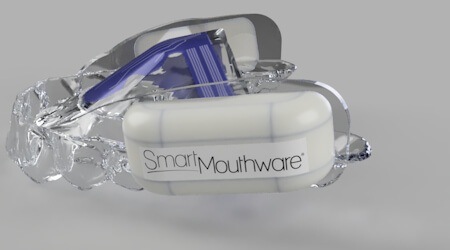Tongue-Controlled Mouse Built Into Dental Retainer
Author: JJ Moritz, President, Sapien LLC
Published: 2020/08/02 - Updated: 2025/11/11
Publication Type: Product Release, Update
Category Topic: Assistive Technology - Academic Publications
Page Content: Synopsis - Introduction - Main - Insights, Updates
Synopsis: This product describes Smart Mouthware™, a tongue-operated computer mouse developed by Fort Collins-based Sapien LLC that addresses a genuine gap in assistive technology performance. The device consists of a touchpad integrated into an orthodontic retainer, allowing users to control computers and phones by moving their tongue across the roof of their mouth, with clicking functions performed by flattening the tongue and scrolling activated through rapid flicking motions.
What makes this information particularly useful is that it comes directly from the company president working alongside Colin Heffern, a landscape architect with quadriplegia who tested the prototypes and confirmed the device's advantages over existing head-tracking mice, which require cumbersome extra actions for right-clicking and scrolling. The developers' deliberate choice to crowdfund rather than seek traditional investment demonstrates their commitment to keeping the cost around $400, recognizing that insurance typically doesn't cover such technology and many potential users face strict Medicaid wealth limits that make affordability critical for people with spinal cord injuries and other conditions affecting hand mobility - Disabled World (DW).
Introduction
Fort Collins startup builds retainer to control your computer and phone. JJ Moritz and Matt Schultz have created an orthodontic retainer that allows a user to control their phone or computer with their tongue.
Main Content
Sapien LLC makes assistive technology and neuroscience research tools and is based in Fort Collins, CO. Founded in 2014 by Dr. John Williams and JJ Moritz, the company aims to create products that enable and empower people.
The engineers began working full-time on this project in November 2019 and are collaborating with Colin Heffern, a landscape architect with quadriplegia and staff at Craig Hospital, to test the first set of prototypes. They aim to develop a computer mouse for people with disabilities that is as fast as a hand-operated mouse.
"Most mouse options for people who are disabled are slow in one way or another. Colin was frustrated with the head-tracking mouse he used because he had to perform different actions every time he wanted to right-click or scroll. We've solved that problem," states JJ Moritz.

The Smart Mouthware™ Computer Mouse they have developed is a touchpad built into the roof of an orthodontic retainer that allows the users to move the cursor by moving their tongue across the roof of their mouth. Clicking (left, right-click, and click-drag) is performed by flattening the tongue against the roof of the mouth, and scrolling is performed by rapidly flicking the tongue across the pad in the desired direction of the scroll.
"It allows full functionality of the mouse, which seems to be pretty slick," states Colin in a YouTube review of the current prototype.
In that video, Colin explains some improvements that will need to be in the final product but says that the current prototype does allow him to click and perform actions like right-right-clicking easily. He is also excited to have one piece of technology to control his computer and phone.
JJ and Matt funded the project for several months, then launched a crowdfunding campaign in February. JJ Moritz states that they chose to crowdfund (as opposed to taking loans or investments) to keep the final product cost down.
"Insurance won't cover most assistive technology, and people on Medicaid in Colorado have a strict limit on the amount of wealth they can have, so we have to keep this product affordable for someone with an injury. If we took investor money or loans early on, we would have to set the product cost much higher to repay that money," explains Mr. Moritz.
The goal is to keep the cost for a single device around $400, though Moritz admits that is getting hard to achieve, as the donations to their crowdfunding campaign have slowed down. Regardless, they hope to launch the product in October of this year after additional user testing and improvements.
Insights, Analysis, and Developments
Editorial Note: The Smart Mouthware development highlights a persistent challenge in assistive technology: balancing innovation with accessibility in both function and cost. While tongue-controlled devices aren't entirely new - other research has explored similar interfaces - this practical implementation reflects valuable lessons learned from real users like Colin Heffern, whose direct feedback about the limitations of head-tracking systems shaped the design. The project's trajectory since its 2020 announcement deserves continued attention, as the gap between prototype demonstration and market-ready product often proves wider than anticipated, particularly for small companies trying to maintain affordability while meeting medical device standards and securing sustainable manufacturing - Disabled World (DW).Attribution/Source(s): This quality-reviewed publication was selected for publishing by the editors of Disabled World (DW) due to its relevance to the disability community. Originally authored by JJ Moritz, President, Sapien LLC and published on 2020/08/02, this content may have been edited for style, clarity, or brevity.